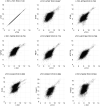Functional redox links between lumen thiol oxidoreductase1 and serine/threonine-protein kinase STN7
- PMID: 33620491
- PMCID: PMC8195503
- DOI: 10.1093/plphys/kiab091
Functional redox links between lumen thiol oxidoreductase1 and serine/threonine-protein kinase STN7
Erratum in
-
Erratum to: Functional redox links between lumen thiol oxidoreductase1 and serine/threonine-protein kinase STN7.Plant Physiol. 2021 Nov 3;187(3):1837. doi: 10.1093/plphys/kiab267. Plant Physiol. 2021. PMID: 34618045 Free PMC article. No abstract available.
Abstract
In response to changing light quantity and quality, photosynthetic organisms perform state transitions, a process which optimizes photosynthetic yield and mitigates photo-damage. The serine/threonine-protein kinase STN7 phosphorylates the light-harvesting complex of photosystem II (PSII; light-harvesting complex II), which then migrates from PSII to photosystem I (PSI), thereby rebalancing the light excitation energy between the photosystems and restoring the redox poise of the photosynthetic electron transport chain. Two conserved cysteines forming intra- or intermolecular disulfide bonds in the lumenal domain (LD) of STN7 are essential for the kinase activity although it is still unknown how activation of the kinase is regulated. In this study, we show lumen thiol oxidoreductase 1 (LTO1) is co-expressed with STN7 in Arabidopsis (Arabidopsis thaliana) and interacts with the LD of STN7 in vitro and in vivo. LTO1 contains thioredoxin (TRX)-like and vitamin K epoxide reductase domains which are related to the disulfide-bond formation system in bacteria. We further show that the TRX-like domain of LTO1 is able to oxidize the conserved lumenal cysteines of STN7 in vitro. In addition, loss of LTO1 affects the kinase activity of STN7 in Arabidopsis. Based on these results, we propose that LTO1 helps to maintain STN7 in an oxidized active state in state 2 through redox interactions between the lumenal cysteines of STN7 and LTO1.
© The Author(s) 2021. Published by Oxford University Press on behalf of American Society of Plant Biologists.
Figures





Comment in
-
Tuning the transitions: a thioredoxin regulates STATE TRANSITION 7 kinase during photoacclimation.Plant Physiol. 2021 Jun 11;186(2):814-815. doi: 10.1093/plphys/kiab128. Plant Physiol. 2021. PMID: 33760058 Free PMC article. No abstract available.
Similar articles
-
Lumen Thiol Oxidoreductase1, a disulfide bond-forming catalyst, is required for the assembly of photosystem II in Arabidopsis.Plant Cell. 2011 Dec;23(12):4462-75. doi: 10.1105/tpc.111.089680. Epub 2011 Dec 30. Plant Cell. 2011. PMID: 22209765 Free PMC article.
-
The phosphorylation status of the chloroplast protein kinase STN7 of Arabidopsis affects its turnover.Plant Physiol. 2011 Dec;157(4):2102-7. doi: 10.1104/pp.111.187328. Epub 2011 Oct 5. Plant Physiol. 2011. PMID: 21976483 Free PMC article.
-
Activation of the Stt7/STN7 Kinase through Dynamic Interactions with the Cytochrome b6f Complex.Plant Physiol. 2016 May;171(1):82-92. doi: 10.1104/pp.15.01893. Epub 2016 Mar 3. Plant Physiol. 2016. PMID: 26941194 Free PMC article.
-
Optimizing photosynthesis under fluctuating light: the role of the Arabidopsis STN7 kinase.Plant Signal Behav. 2010 Jan;5(1):21-5. doi: 10.4161/psb.5.1.10198. Plant Signal Behav. 2010. PMID: 20592803 Free PMC article. Review.
-
Protein kinases and phosphatases involved in the acclimation of the photosynthetic apparatus to a changing light environment.Philos Trans R Soc Lond B Biol Sci. 2012 Dec 19;367(1608):3466-74. doi: 10.1098/rstb.2012.0064. Philos Trans R Soc Lond B Biol Sci. 2012. PMID: 23148273 Free PMC article. Review.
Cited by
-
Chloroplast acetyltransferase GNAT2 acts as a redox-regulated switch for state transitions in tomato.Mol Hortic. 2025 Aug 6;5(1):39. doi: 10.1186/s43897-025-00164-0. Mol Hortic. 2025. PMID: 40764949 Free PMC article.
-
Biochemical analysis, photosynthetic gene (psbA) down-regulation, and in silico receptor prediction in weeds in response to exogenous application of phenolic acids and their analogs.PLoS One. 2023 Mar 23;18(3):e0277146. doi: 10.1371/journal.pone.0277146. eCollection 2023. PLoS One. 2023. PMID: 36952510 Free PMC article.
-
Current Insights into the Redox Regulation Network in Plant Chloroplasts.Plant Cell Physiol. 2023 Jul 17;64(7):704-715. doi: 10.1093/pcp/pcad049. Plant Cell Physiol. 2023. PMID: 37225393 Free PMC article. Review.
-
ROS production and signalling in chloroplasts: cornerstones and evolving concepts.Plant J. 2022 Aug;111(3):642-661. doi: 10.1111/tpj.15856. Epub 2022 Jun 28. Plant J. 2022. PMID: 35665548 Free PMC article. Review.
-
Photosystems under high light stress: throwing light on mechanism and adaptation.Photosynthetica. 2023 May 30;61(2):250-263. doi: 10.32615/ps.2023.021. eCollection 2023. Photosynthetica. 2023. PMID: 39650670 Free PMC article. Review.
References
-
- Belgio E, Kapitonova E, Chmeliov J, Duffy CD, Ungerer P, Valkunas L, Ruban AV (2014) Economic photoprotection in photosystem II that retains a complete light-harvesting system with slow energy traps. Nat Commun 5: 4433. - PubMed
-
- Bellafiore S, Barneche F, Peltier G, Rochaix JD (2005) State transitions and light adaptation require chloroplast thylakoid protein kinase STN7. Nature 433: 892–895 - PubMed
-
- Bergner SV, Scholz M, Trompelt K, Barth J, Gabelein P, Steinbeck J, Xue H, Clowez S, Fucile G, Goldschmidt-Clermont M, et al. (2015) STATE TRANSITION7-dependent phosphorylation is modulated by changing environmental conditions, and its absence triggers remodeling of photosynthetic protein complexes. Plant Physiol 168: 615–634 - PMC - PubMed
Publication types
MeSH terms
Substances
LinkOut - more resources
Full Text Sources
Other Literature Sources
Molecular Biology Databases
Research Materials

